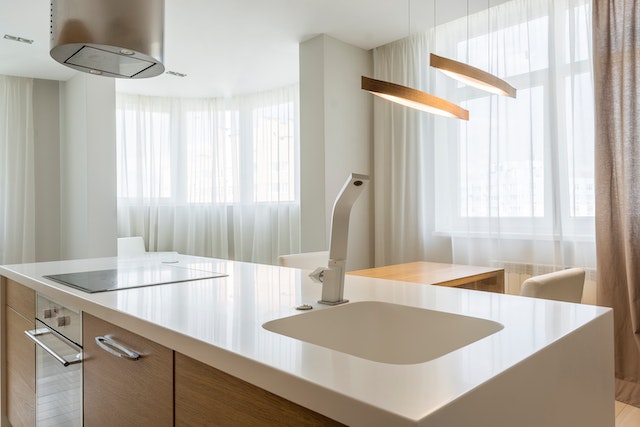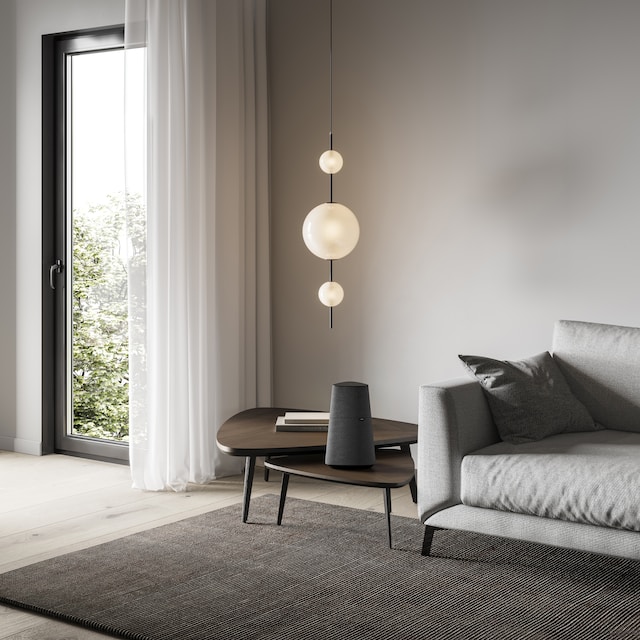
Minimalism reigns supreme in the realm of contemporary interior design. This aesthetic philosophy is all about simplicity, clean lines, and the essence of functionality. And what better way to complement a minimalist interior than with the perfect lighting fixture?
In the world of minimalism, less is truly more. Gone are the days of ornate chandeliers and extravagant light fixtures stealing the spotlight. Instead, sleek and understated designs take center stage, effortlessly blending into the overall design while providing a subtle but crucial element of illumination.
Minimalist lighting fixtures are designed with a fundamental goal in mind: to create an uncluttered visual experience without compromising on quality or efficiency. These fixtures boast a refined elegance, relying on simplicity and functionality to enhance the beauty of a space rather than overpowering it.
Benefits of Minimalist Lighting Fixtures:
Enhancing the Sense of Space: One of the key benefits of using minimalist lighting fixtures is their ability to create an illusion of more space. By eliminating unnecessary clutter and focusing on clean lines, these fixtures allow for a more open and airy ambiance. This is particularly beneficial for smaller rooms or apartments where maximizing space is essential.
Promoting a Harmonious Design: Minimalist lighting fixtures seamlessly integrate into any design scheme, making them a versatile choice for both traditional and contemporary interiors. Their understated elegance acts as a unifying element, bringing harmony to the overall aesthetic. Whether your home boasts a Scandinavian-inspired decor or a mid-century modern vibe, minimalist lighting fixtures will effortlessly blend in, without overpowering the existing design elements.
Fostering a Calming Atmosphere: In today’s fast-paced world, creating a serene and inviting haven within our homes has become crucial. Minimalist lighting fixtures contribute to this by emitting soft, warm light that exudes a sense of tranquility. Instead of harsh overhead lighting, these fixtures offer a more gentle and soothing glow, helping to create a calming environment that promotes relaxation and reflection.
Clean and Simple Pendant Lights
Pendant lights are a popular choice when it comes to minimalist lighting fixtures. With their clean lines and understated designs, they effortlessly blend into any space, adding a touch of elegance and functionality. Here are some key features and practical tips to consider when selecting and incorporating clean and simple pendant lights into your minimalist interior:

Key Features:
Sleek and Streamlined: Clean and simple pendant lights often feature sleek and streamlined designs, free from unnecessary embellishments. They embody the essence of minimalism, offering a minimalist aesthetic without compromising on style or functionality.
Minimalistic Materials: When choosing pendant lights for your minimalist space, consider materials such as matte metal, frosted glass, or even fabric. These materials not only add to the minimalist aesthetic but also create a soft and warm illumination when the light is turned on.
Versatile Lighting Options: Pendant lights come in various sizes, shapes, and styles, allowing you to customize the lighting in your space. Opt for adjustable pendant lights or those that can be paired with dimmer switches, giving you control over the ambiance and brightness levels.
Practical Tips:
- Opt for Neutral Colors: To maintain the simplicity of your minimalist space, choose clean and simple pendant lights in neutral colors such as white, black, or gray. These colors blend seamlessly with any decor and enhance the overall minimalist aesthetic.
- Consider Different Heights: Pendant lights offer flexibility in terms of height adjustments. Experiment with varying heights to create visual interest and add depth to your space. Hang pendant lights at different levels over a dining table or kitchen island, creating a contemporary and dynamic look.
- Grouping and Clustering: For a striking and unique effect, consider grouping or clustering clean and simple pendant lights together. This creates a focal point and adds a sculptural element to your space. Choose pendant lights of identical designs or mix and match various styles for an eclectic twist.
- Illuminate Specific Areas: Use clean and simple pendant lights strategically to illuminate specific areas of your minimalist interior. Install a pendant light above a reading nook, kitchen counter, or bathroom vanity to provide focused and functional lighting while enhancing the overall aesthetic.
Sleek and Functional Track Lighting
Track lighting is a popular choice among minimalist enthusiasts due to its simple yet versatile design. With its sleek and unobtrusive track system, this type of lighting provides a practical solution for illuminating various areas of your minimalist interior while maintaining a clean aesthetic.
Practical Tips for Using Track Lighting in a Minimalist Interior:
Opt for Adjustable Fixtures: One of the main advantages of track lighting is its ability to provide targeted illumination. To maximize its functionality, choose fixtures that offer adjustable heads or spotlight-like options. This allows you to direct the light where it’s needed most, whether it’s highlighting artwork, accentuating architectural features, or creating task lighting in specific areas.
Choose a Monochromatic Color Palette: To maintain the simplicity and elegance of your minimalist space, opt for track lighting fixtures that blend seamlessly with the rest of the room. Consider choosing fixtures in a monochromatic color palette, such as black, white, or metallic finishes, as they will effortlessly complement your minimalist interior without drawing unnecessary attention.
Pay Attention to Placement: When installing track lighting, carefully consider the placement and arrangement of the fixtures. Create a lighting scheme that enhances the flow and functionality of your space. Use track lighting to define different zones within an open floor plan or to emphasize specific areas, such as kitchen islands, dining tables, or home offices. Experiment with different configurations to achieve the desired lighting effect.
Keep Wiring Hidden: Minimalist design is all about clean lines and clutter-free spaces. To maintain this aesthetic, ensure that the wiring for your track lighting is neatly concealed. Opt for track lighting systems that allow for hidden wiring or consider professional installation to achieve a seamless and clean look.
Consider Dimming Options: To create a versatile lighting experience in your minimalist interior, consider incorporating dimming options into your track lighting system. This allows you to adjust the brightness of the lights based on your needs and preferences, from ambient lighting for relaxation to brighter lighting for tasks or gatherings.
Embrace Minimalist Track Designs: Just like other minimalist lighting fixtures, track lighting comes in various designs. Embrace clean and simple track designs that align with the minimalist aesthetic. Choose tracks with sleek profiles and minimal connectors, as they will seamlessly blend into your space while providing the necessary functionality.

Recessed Lighting for a Streamlined Look
When it comes to achieving a truly minimalist aesthetic, recessed lighting is an excellent choice. This type of lighting provides a sleek and streamlined look, seamlessly integrating into the architecture and design of your space. Here are some practical tips for incorporating recessed lighting into your minimalistic interior.
Focus on Functionality: Recessed lighting is not only about looks; it is highly functional as well. Install recessed lights strategically to provide optimal lighting in different areas of your space. Use them to highlight artwork, provide task lighting in workspaces, or create ambient lighting in larger areas.
Consider Different Lighting Effects: With recessed lighting, you have the flexibility to choose between different lighting effects. Opt for directional recessed lights to highlight specific features or adjust the angle of the lights to create a more dramatic effect. You can also choose between warm or cool lighting to suit the mood and ambiance you want to create.
Plan Ahead: Before installing recessed lighting, it’s crucial to plan ahead. Consider the layout and functionality of your space and identify the areas where recessed lighting would be most beneficial. Work closely with a professional electrician or lighting designer to ensure that your lighting design aligns with your vision and meets your specific needs.
Choose the Right Trim: Recessed lighting fixtures come with various trim options, allowing you to customize the look and feel of your lighting. Opt for trim styles that align with your minimalist aesthetic. Clean and simple trims, such as round or square, in neutral finishes will maintain the simplicity of your space.
Create Lighting Zones: Just like with track lighting, use recessed lighting to create different lighting zones within your minimalist interior. This allows you to have layered lighting that can be adjusted based on the activities or moods you want to achieve. Create separate zones for ambient, task, and accent lighting to provide versatility and customization.
Pay Attention to Spacing: Proper spacing of recessed lighting is essential to achieve the desired lighting effect. Follow recommended guidelines for spacing between fixtures to ensure even illumination throughout the space. Consult with a lighting professional to determine the appropriate spacing based on the size and layout of your room.
Use Dimmers: To further enhance the versatility of your recessed lighting, consider installing dimmers. Dimmers allow you to adjust the brightness of your lights, creating different lighting levels for various occasions. From bright and energetic to soft and cozy, dimmers give you control over the ambiance and mood of your space.
Minimalist Floor and Table Lamps to Illuminate your Space

In the realm of minimalist interior design, every element should serve a purpose and contribute to the overall aesthetic. When it comes to lighting, floor and table lamps play a crucial role in providing both functional illumination and enhancing the minimalist vibe of a space. With their clean lines and simple designs, these lamps seamlessly merge form and function to create a harmonious ambiance in your minimalist interior. Here are some practical tips for incorporating minimalist floor and table lamps into your space.
Floor Lamps:
Floor lamps are an excellent choice for adding a soft, ambient glow to your minimalist interior. They not only provide necessary light but also act as a statement piece that adds depth and visual interest to a room. When selecting a minimalist floor lamp, consider the following tips:
- Slim and Streamlined Designs: Look for floor lamps with slim profiles and sleek, streamlined designs. Avoid overly ornate or bulky lamps that may overpower the minimalist aesthetic. Instead, opt for simple lines and minimal embellishments.
- Adjustable Lighting: Choose floor lamps with adjustable features such as height or light direction. This allows you to customize the lighting based on your needs and preferences, whether you want to create a cozy reading nook or illuminate the entire room.
- Materials Matter: Embrace natural and minimalistic materials such as wood, metal, or even fabric shades. These materials not only add warmth and authenticity to your space but also enhance the overall minimalistic aesthetic.
Table Lamps:
Table lamps are essential for creating focused task lighting or providing ambient light in specific areas of your minimalist interior. They offer versatility and functionality while seamlessly blending into your design scheme. When selecting minimalist table lamps, consider the following tips:
- Clean and Simple Shapes: Opt for table lamps with clean and simple shapes such as cylinders, squares, or spheres. These geometric forms align with the minimalist aesthetic and create visual harmony with the rest of your space.
- Subtle Colors: Choose table lamps in neutral colors such as white, black, or gray. These colors ensure that the lamps complement rather than overpower the minimalistic vibe of your interior. If you desire a touch of color, select muted tones that blend seamlessly with the overall palette.
- Size and Proportion: Consider the size and proportion of your table lamps in relation to the furniture and surfaces they will be placed on. The lamp should be in proportion to the table or desk to create a visually pleasing arrangement.
- Dimmable Options: Opt for table lamps with dimmable features or pair them with dimmer switches to have control over the lighting levels. This flexibility allows you to create different moods and adjust the brightness according to your needs.
- Minimalist Lampshades: When it comes to lampshades, keep it minimal. Choose lampshades made of simple, light-filtering materials like fabric or frosted glass. Avoid elaborate patterns or excessive embellishments that may distract from the minimalist aesthetic.
Maximizing Natural Light:

Natural light is a prized asset in any minimalist interior. It not only illuminates our spaces but also connects us to the outside world, creating a sense of harmony and tranquility. Maximizing natural light can greatly enhance the minimalist aesthetic, promoting a bright and open atmosphere while reducing the need for artificial lighting. Here are some practical tips on how to optimize natural light in your space.
Keep windows and skylights clean: Cleanliness is key when it comes to optimizing natural light. Make sure your windows and skylights are free from dirt, grime, and dust that can hinder the passage of sunlight. Regularly clean your windows and wipe down skylights to ensure maximum light penetration.
Use sheer curtains or blinds: When it comes to window treatments, opt for sheer curtains or blinds that allow ample natural light to filter through. Avoid heavy or dark curtains that block light and create a gloomy atmosphere. Sheer fabrics in light colors not only allow light to pass through but also add a soft and ethereal touch to your minimalist interior.
Reflective surfaces: Incorporate reflective surfaces such as mirrors, glass tabletops, or glossy finishes to bounce natural light around the room. Strategically place these surfaces in areas that receive the most sunlight to amplify the brightness and create a sense of spaciousness.
Minimalist window coverings: If privacy is a concern, consider minimalist window coverings that provide a balance between privacy and light optimization. Frosted or translucent films on windows, or the use of sheer roller blinds, can maintain privacy while still allowing natural light to filter through.
Use light-colored materials: Choosing light-colored materials for your walls, ceilings, and floors can help maximize the effect of natural light in your space. Opt for white or neutral colors that reflect light and create a bright, airy ambiance. Avoid dark, heavy materials that absorb light and make the space feel smaller.
Open floor plans: Embrace open floor plans that allow for uninterrupted flow of natural light throughout the space. Remove unnecessary walls or partitions that hinder the passage of light and create a more spacious and light-filled atmosphere.
Incorporate light wells: Light wells, also known as light shafts or light tunnels, are architectural features that can bring natural light into areas that lack windows or receive limited sunlight. These vertical shafts or tunnels are designed to capture sunlight from the roof or outside and direct it into the interior space, brightening up even the darkest corners of your home.
Use interior design elements to amplify natural light: Consider using interior design elements such as strategically placed mirrors, wall art, or light-colored furniture to reflect and amplify natural light. These additions can create a sense of depth and dimension, making your space feel more expansive and inviting.
Trim or remove outdoor foliage: Overgrown trees or shrubs near your windows can cast shadows and block natural light from entering your space. Keep outdoor foliage well-trimmed or consider removing it altogether to allow an unobstructed flow of sunlight.
Maximize natural light in specific areas: Identify areas in your space that are naturally darker or receive limited sunlight, and consider employing specific techniques to maximize natural light in those areas. This can include adding strategically placed mirrors, using lighter paint colors, or rearranging furniture to allow light to penetrate those spaces.
In the world of minimalism, lighting serves a dual purpose – illuminating the space and enhancing the aesthetic. With careful consideration and attention to detail, you can create a minimalist interior that radiates tranquility and sophistication, where every lighting fixture plays a pivotal role in creating a harmonious visual experience.
